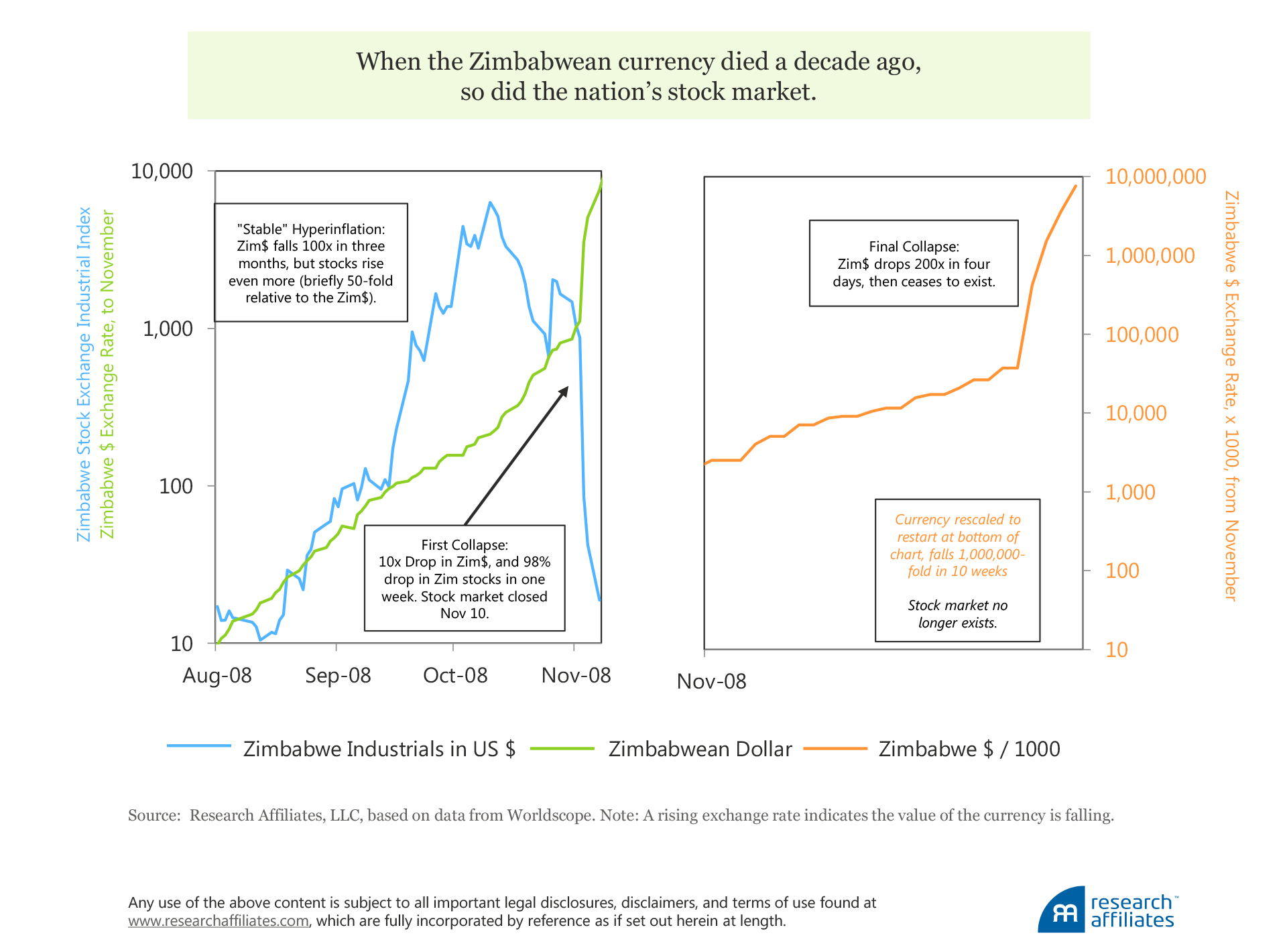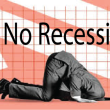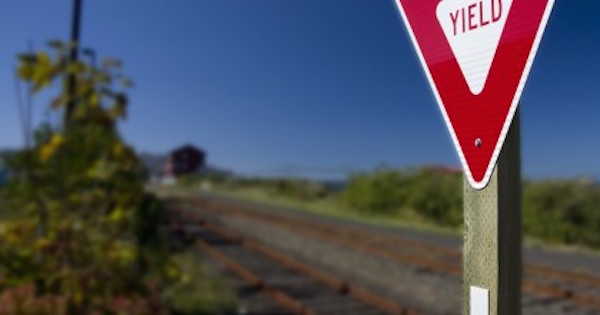by Rob Arnott, Shane Shepherd, and Bradford Cornell, Research Affiliates
Key Points
- The word “bubble” is tossed around with abandon. We offer a rigorous definition for the word, and then test the definition against current markets.
- Several bubbles are evident today, most importantly a tech bubble, eerily similar to—albeit narrower than—the “new economy” dogma of the 2000–2001 dot-com bubble. We also see a bubble brewing in cryptocurrencies and micro-bubbles in select stocks such as Tesla.
- Investors can take action to protect their portfolios and potentially benefit from the bubble by reducing exposure to bubble assets; seeking out exposure to anti-bubbles, where assets or markets are irrationally cheap; investing in value-based smart beta strategies especially in European and emerging markets; and avoiding capitalization-weighted index funds, which inherently overweight the bubble assets.
- Finally, we must be patient. Bubbles typically continue longer than expected, until they suddenly pop.
“The market can stay irrational longer than you can stay solvent.” 1
The relentless rise in the US stock market since its low in 2009 has been dramatic. US stock market valuations now exceed all historical valuation levels, except for those hit at the peak of the dot-com craze. This raises an obvious question for investors: Today, in early 2018, and has been the case over the last year, is the US stock market in another bubble? Yes. The more important question then becomes: How should investors react? We recommend four actions investors can take in response to the current bubble conditions, which should actually allow investors to benefit from the bubble.
What Constitutes a Bubble?
To address these questions, let’s begin by offering a definition of the word “bubble.” We all hear the word thrown around carelessly and often, but it lacks a formal definition. Let’s try. Ockham’s Razor guides us: Keep it simple. We define a bubble as a circumstance in which asset prices 1) offer little chance of any positive risk premium relative to bonds or cash, using any reasonable projection of expected cash flows, and 2) are sustained because investors believe they can sell the asset to someone else for a higher price tomorrow, with little regard for the underlying fundamentals. Notably, there are markets in which few, if any, buyers care about discounted future cash flows to value the asset. In order to identify a market bubble, we need to strongly believe our definition applies. Borderline calls don’t qualify.
Most academics, especially adherents of neoclassical finance, will dismiss our arguments. After all, for every seller, there’s a buyer—because some investors like an asset at the prevailing price, the market must be efficient! Impressive economic models, which include variants on investor utility or additional sources of risk, have been developed to allow a risk premium model to explain bubbles, crashes, and puzzles, such as excessive volatility in price-to-dividend ratios.2
The efficient market hypothesis has been stretched to fit observed market behavior, by allowing cross-sectional and intertemporal variations in risk premia. Prices adjust until the marginal investor becomes willing to assume both market risk and assorted factor-related risks. The market’s willingness to bear these risks varies over time. In this view, high valuation levels don’t represent mispricing; the risk premia just happen to be sufficiently low so as to justify the prices.
These models benefit from being constructed on a post hoc basis to be consistent with market events. Fair enough, because a useful model needs to be consistent with observable data. But the models often shift problems in the observable data, such as puzzlingly high volatility in price-to-dividend ratios, into unobservable nooks and crannies. In other words, perhaps bubble-like prices can be perfectly rational as long as we accept curiously high volatility in the curvature of investors’ utility functions. Sadly, these hypotheses and models lack a key attribute of scientific method: they are unfalsifiable. No practical difference exists between an inefficient market and an efficient market in which risk premia vary in this fashion.
That said, we do have some observations on investor behavior and expectations. Vernon Smith won the Nobel Prize for his groundbreaking work in experimental economics, including experiments that showed bubbles and crashes occurring in normal economic settings. Smith showed that even though investors share the same information, they do not come to the table with common expectations. As a result, even when market participants are all aware of a formula-based value for an asset, they will overpay or underpay relative to a known fair valuation. The academic phrasing Smith, Suchanek, and Williams (1988) used—“agent uncertainty about the behavior of others”—can more commonly manifest as the self-evident presumption of a greater fool. True, the students in their experiments were trading in laboratory settings, not real markets, but the studies have been repeated with seasoned investment professionals, with similar results. As Smith later remarked (Altman, 2002): “It took me several years to realize that the textbooks were wrong, and the people in my class were correct.”
More recent research shows how investor expectations around “greater fools” and future price movements are strongly influenced by recent market returns, further encouraging the formation of bubbles. Greenwood and Shleifer (2013) studied six sources of survey data of investor expectations for future market returns. They showed that investors behave with strong extrapolative tendencies: following periods of strong market returns, investors become used to strong performance and extrapolate it into their expectations of future market returns. For example, a Gallup survey showed that investors increasing their expected market return from 12% in mid-1998 to 16% by early 2000. By the end of 2002 this number had fallen to 6%.
Under certain conditions (i.e., following times of high prices and low yields), investors will raise their estimates of future market returns. Of course, this is exactly the opposite response of what a time-varying risk premium model or an even simpler Shiller PE (price-to-earnings) valuation tool would suggest. Furthermore, Greenwood and Shleifer showed that investors put their money where their mouths are: mutual fund flows into the equity markets correlate quite strongly with the investor expectations captured by the surveys. Clearly, investors allow their return expectations to drift from reasonable models of fair valuation, and instead expect future buyers to pay even higher prices for stocks with already sky-high valuations, which, of course, they do—until they don’t—and the market collapses.
It’s a Bubble Because …
Our view is that the market constantly creates single-asset micro-bubbles, isolated examples of extreme mispricing which require severe right-tail outcomes to justify the asset’s price. Over the first quarter of 2018, Tesla has been an excellent example of a micro-bubble. Tesla’s current price is arguably fair if most cars are powered by electricity in 10 years, if most of these cars are made by Tesla, if Tesla can make those cars with sufficient margin and quality control and can service the cars properly, and if Tesla can raise additional capital sufficient to cover a $3 billion annual cash drain and another billion to service its debt. To us, that seems an unduly optimistic array of assumptions, especially given the magnitude of Tesla’s debt burden. Such an argument ignores the deep pockets of competitors and the common phenomenon of disruptors being themselves disrupted by newcomers. Absent the unfolding of this rosy scenario, Tesla’s current price would require remarkably aggressive assumptions to deliver a positive risk premium. For investors who agree with this assessment, Tesla constitutes a single-stock micro-bubble.3 This example also illustrates a key point about bubbles: Because the current price is acceptable to the marginal buyer and seller, there will always be a cohort that says, “This is no bubble!”
Sector and broad market bubbles are much rarer events. In this context, a bubble occurs in a sector or a market for which an implausible set of circumstances must prevail in order for the sector or market to collectively deliver a positive risk premium relative to bonds or cash, even though sufficiently aggressive assumptions could realistically occur to justify any single stock’s price.
The 1999–2000 tech, or dot-com, bubble is the poster child for a broad market bubble. At the height of the bubble, aggressive assumptions were required to believe the entire US stock market would deliver a positive risk premium relative to then-prevailing bond and cash yields (Arnott and Ryan, 2001). For the tech sector, in particular, to deliver a positive risk premium compared to the 6% bond yield at that time, most tech stocks would have had to produce rapid growth far into the future, even though few could have succeeded unless their fiercest competitors were struggling. In hindsight, using our simple definition, the tech bubble was indeed a bubble. More importantly, many observers in the midst of the bubble correctly perceived it for what it was (Asness, 2000).
At the beginning of 2000, the 10 largest market-cap tech stocks in the United States, collectively representing a 25% share of the S&P 500 Index—Microsoft, Cisco, Intel, IBM, AOL, Oracle, Dell, Sun, Qualcomm, and HP—did not live up to the excessively optimistic expectations. Over the next 18 years, not a single one beat the market: five produced positive returns, averaging 3.2% a year compounded, far lower than the market return, and two failed outright. Of the five that produced negative returns, the average outcome was a loss of 7.2% a year, or 12.6% a year less than the S&P 500.
Eerily similar to the “new economy” dogma of the dot-com bubble is today’s cryptocurrency craze. It boggles the imagination to hear people speaking of “investing” in bitcoin, an electronic entity that offers no hope of future operating profits or dividends, is little used as a surrogate for money in transactions (trading volume is well over 100 times as large as spending volume), offers an uncertain longer-term use case, and has no objective basis to determine fundamental value. Will bitcoin and a handful of other cryptocurrencies settle in and become a stable store of value, akin to gold or sovereign currencies? Perhaps. Those of us who are libertarians, wary of government control of the money supply, are rooting for that outcome. That said, how many investors are holding cryptocurrencies for any purpose other than the expectation that someone else will pay a higher price at some point in the future?
Arguments for the future value of cryptocurrencies bring back fond memories of the “price-to-eyeballs” metrics used to justify the market cap of businesses such as Pets.com. Nonetheless, the price of bitcoin rose by 1,369% in 2017.4 Even if we assume that bitcoin has merit as a libertarian alternative to government-sourced fiat currency, it’s hard to justify today’s 1,500 different cryptocurrencies. Many of these were launched with the singular goal of making the originator of the cryptocurrency wildly wealthy in an ICO (initial coin offering).
It’s harder still to justify the myriad exchanges, which offer only a receipt indicating the purchaser owns cryptocurrencies on their platform, many of which have been hacked, costing customers billions. As for the platforms that offer lofty interest rates to those who lend them cryptocurrency, little doubt exists many of these operators intend to convert your cryptocurrency into their own “kleptocurrency.” And now, bitcoin futures permit leveraged investments in one of the most volatile “assets” ever created.
The speculative nature of the cryptocraze cements, in our minds, its bubble status. Anecdotal stories abound of individuals looking for a once-in-a-lifetime opportunity to get ahead or to rescue their severely underfunded retirement plans (Harlan, 2018), buying cryptocurrencies because they are driven by a fear of missing out (Aslam, 2018), and paying prices only justified by extrapolating wildly positive price trends. A recent survey of fintech leaders, certainly a biased sample but the group likely most heavily involved in trading cryptocurrencies, forecast returns for calendar year 2018 ranging from 95% to 2,920% for the top 10 cryptocurrencies.5 Pity the unlucky investor who selects the only cryptocurrency that fails to even double in value!
The bitcoin bubble also serves as a wonderful example of how bubbles create harmful distortions in the real economy. The website Digiconomist estimates the run-rate annual electricity utilization of the bitcoin network at 56 billion kilowatt-hours. That’s more than enough to power all the households in Los Angeles for a year, and nearly enough to meet all of Israel’s power demands. Bitcoin already consumes about 0.25% of total global electricity consumption! All just to “produce” new coins on a nonphysical ledger and move these coins around on electronic exchanges.6 Will we someday find that all of this energy consumption has gone to waste?7
We see a bubble in the US stock market today, albeit less extravagant than Tesla or the growing swarm of cryptocurrencies. Reasonable observers can disagree, but we believe we are experiencing a tech bubble, based on our relatively rigorous definition of the term.8 At the end of January 2018, the seven largest-cap stocks in the world were all tech fliers: Alphabet, Apple, Microsoft, Facebook, Amazon, Tencent, and Alibaba. Never before has any sector so dominated the global roster of largest market-cap companies. At the peak of the tech boom, four of the top seven companies by market cap were in the tech sector, and at the peak of the oil bubble, five of the top seven were in the energy sector. Only the Japanese stock market’s bubble at yearend 1989 has matched today’s tech sector dominance of the global market-capitalization league tables.9 Not only do we have the FANGs, we have FANG+ futures, affording investors a chance to buy the world’s trendiest tech stocks with almost no collateral, and the list is amended quarterly to make sure only the trendiest are on the list.
History shows that, on average, just two stocks from the global market-cap top 10 list remain on the list a decade later. The two survivors almost always include the number-one stock. But the number-one stock has never been top dog a decade later, ultimately underperforming and moving lower in the list. The second surviving stock has 50/50 odds of beating the market. If this history repeats, nine of the top 10 market-cap stocks will underperform the market over the next 10 years, and just one has a 50% chance of underperforming. We don’t particularly like those 95% odds.
Can all of the seven tech highfliers collectively succeed to sufficiently justify their $4.3 trillion combined market capitalization at yearend 2017? Nothing is impossible, but this outcome is implausible. Sure, some of the new tech giants are at valuation multiples that are not extravagant, but several sport startling multiples—and all trade at levels that require robust continued growth. These companies are at war—in some cases directly with one another—for market share, competing for the same eyeballs, and are facing a growing risk of regulatory constraints. If history is a useful guide, Apple may still be in the top 10 list (but no longer number one) in 2028, and perhaps one of the others will still be on the list. History would suggest that, of the seven, at least six will underperform the market over the next 10 years. Beyond the top-tier tech favorites, a host of companies such as Snap, Hubspot, Overstock, and now Shopify each have negative earnings and lofty price-to-sales ratios.
Not only are the market prices of most tech darlings far above reasonable valuation models, investors are overwhelmingly positive and projecting high future returns. Consider some of the investor sentiment measures described by Greenwood and Shleifer (2013). The Wells Fargo/Gallup Investor and Retirement Optimism Index sits at its highest level in 17 years, and 49% of respondents (also an all-time high) indicate either “a great deal” or “quite a lot” of confidence in the stock market as a place to invest. The American Association of Individual Investors investor sentiment survey began calendar year 2018 with 59.8% of respondents bullish on the stock market, the highest level in seven years, and a mere 15.6% registering a bearish opinion. The University of Michigan’s Index of Consumer Sentiment now shows an all-time record for favorable assessments of current economic conditions. The Graham–Harvey survey indicates that US CFOs are showing the highest level of optimism ever recorded in the survey’s history, even though the CFOs’ average return expectation for the S&P 500 of 6.6% for 2018 is not extravagant.
We see evidence of bubble behavior in other markets as well.
- Consider the inverse VIX ETFs that allow investors to bet against volatility. In late 2017, the Wall Street Journal published an article that explained how an entirely plausible rise in volatility would be enough to wipe out these funds. Yet investors continued to underappreciate the risk inherent in such strategies, expecting low market volatility to persist, and shrugged off the completely credible “wipe out” scenarios. The money continued to pour in. Just weeks after the Journal’s warning, that exact scenario materialized, with the VIX more than tripling in a single day, wiping out several of the funds in early February 2018.
- Late in 2017, the yield on European junk bonds fell below 2% and below the yield of the 10-year US Treasury bond. In order to justify this remarkable event, we would have to expect a decade of sustained dollar weakness relative to the euro. But it seems that European investors, either because of home-country bias or because of restrictions on foreign holdings, have been so desperate for yield they have priced European junk bonds at levels that more or less assure a negative risk premium.
- At the same time, in late 2017, US junk bonds yielded materially less than emerging market (EM) sovereign debt. To be sure, EM debt is not immune to defaults (e.g., Venezuela and Argentina—several times for each), but the average default rate is less than half that of US junk bonds, especially when we adjust for recovery rates. EM currencies would have to tumble over the coming decade to justify this yield spread. Should we assume that the market is correctly pricing this bleak currency outlook or should we acknowledge that EM sovereign debt is likely to deliver a more positive risk premium than US junk bonds?
So What Is an Investor to Do?
Our purpose in this article is not to prove that current conditions represent a bubble. Reasonable people may reach the opposite conclusion. After all, some level of cash flow expectations can justify any price. It’s a matter of subjective judgment as to whether such lofty cash flow expectations are sensible, implausible, or preposterous. Considering all the caveats required to support current prices, we think tech stocks are at the implausible stage in their collective market value, with some individual stocks (and most cryptocurrencies) at the preposterous level. We believe tech stocks are in another bubble, with the potential to impact investable asset classes far beyond the tech sector, albeit not as extreme as the 1999–2000 bubble, labeled by many “the mother of all bubbles.”
Let’s now focus on how investors should react in response to a bubble. A reasonable first step is to sell, or greatly reduce, our holdings of bubble-priced assets. We must guard against the mistake made by the brilliant Sir Isaac Newton, in the South Sea bubble of the early eighteenth century. Recognizing that a bubble was building in the stock of the South Sea Company, Newton sold his initial investment and booked a quick doubling of his money. He then sat on the sidelines as his friends, who had held on, more than tripled their investment from the point at which he had exited. Newton’s wisdom and initial handsome profits soon seemed like an abject failure compared to his friends’ growing wealth. At last Newton gave in, bought back into the stock near its peak, and lost nearly his entire life’s savings. This brought him to the alleged lament: “I can calculate the movement of heavenly bodies, but not the madness of men.”
The two most dangerous things about a bubble are that 1) markets can go far beyond any objective valuation measure, and 2) investors can never know with any confidence when the bubble will pop and the market will turn. No matter how negative the expected return on cryptocurrencies may be, we can’t rule out the possibility of yet another new currency delivering a 36,000% gain in the coming year, as Ripple did in 2017. Agency issues may even lead sophisticated investors who identify the bubble to buy in and ride the momentum, propagating bubble behavior in the short run (Brunnermeier and Nagel, 2004).
A bubble will eventually pop as investors constantly seek pricing errors they can exploit for profit. Does it make sense, then, to sell short? Shorting is hardly a low-risk strategy, even in a bubble. Typically, downside risk is limited to 100% of our investment, whether we are buying a single stock, a market sector, or the overall market. When we short a stock, sector, or market, our downside risk is no longer limited. The timing difficulty in short selling and the limits to arbitrage encourage the continuation of bubble markets, as the incentives for investors to take the other side of the trade are diminished. Even when virtually assured an eventual profit, short sellers risk losing everything in the short run. To this point, the history of the Zimbabwean hyperinflation provides a disturbing warning.
A Warning from Zimbabwe
The hyperinflation in the Zimbabwean dollar in 2008 and 2009 is well known, but the nation’s stock market bubble during this period, less so.

During the three months August–October 2008, the Zimbabwean dollar plunged from 10 to 1000 per the US dollar, a 100-fold currency collapse. At first, the Zimbabwean stock market was unfazed, rising 500-fold in just eight weeks, while the currency fell 10-fold. Thus, in US dollar terms, the stock market rose an astounding 50-fold over those eight weeks. In the next two weeks, however, the stock market toppled 85% and the currency tumbled another 3-fold. Adjusted for the plummeting Zimbabwean currency, the nation’s stock market plunged 95% in two weeks.
Then, both the currency and the stock market ratcheted up volatility another order of magnitude. When the hyperinflation went into overdrive, with purchasing power falling 90% in less than a week, the stock market fell 98% (99.8%, in US dollar terms) in that same week. The stock market in Zimbabwe then ceased to exist.
Suppose we had the clairvoyance to know the market was going to fall 99% in US dollar terms over that three-month period in 2008. And suppose we could have sold the Zimbabwean market short. The strategy would seem to be a no-lose proposition. But not so fast. Even with the prescience of knowing the market was going to zero in three months, by selling short we would have lost 50 times our money, with high odds of bankruptcy, even though we were eventually proven correct!
Whereas a bubble is not as hard to identify in real time as is commonly perceived, transforming a bubble into profit, even for investors who correctly discern it, is a tremendous challenge because late-stage bubbles can take valuations into the stratosphere.

Bubbles Closer to Home
Consider the plight of an investor who concluded in January 2017 that stock prices, particularly those of the FANGs and their brethren, were in a bubble. Plenty of evidence would have supported the rationality of such a view with most measures of price to cash flow and price to earnings, such as the cyclically adjusted PE (CAPE) ratio, near record highs. The FANGs really looked stretched: Amazon and Netflix had PE ratios in the hundreds.
Let’s say our investor decided to sell his high-priced FANG stocks and moved the proceeds to cash or to more sensibly priced markets. One year later, this cautious investor would have dramatically underperformed his peers, be questioning the wisdom of his decision, and perhaps be weighing the merits of duplicating Isaac Newton’s mistaken market re-entry.10 An alternative strategy of hedging with options, either buying puts or selling calls, would have done nothing but reduce returns relative to investors who held the stocks without hedging. Hedging would have amounted to just another way of underweighting the FANGs and the market in general.
This example is no different from an investor who liquidated tech stocks in early 1999 or who sold-short Zimbabwean stocks in mid-2008. The simple fact is that bubbles will continue until they don’t. The all-too-common question—“What’s the catalyst that will cause the market to turn, the bubble to burst?”—is simply a distraction because a catalyst is, by definition, a surprise to most of the market.
What, for example, was the proximate catalyst that ended the tech bubble in March 2000? We have yet to hear a persuasive answer. Yet, the quest for a catalyst is fun and potentially profitable; after all, a few people will identify the catalyst, if there is one, in advance. Whereas many recognized the naiveté of the view that real estate prices couldn’t fall nationwide in 2007–2008, few predicted an outright crash as a result. Nevertheless, we should recognize that the quest for a catalyst can be quixotic and may be a waste of time.
Investors can actually provide their own most appropriate response to a bubble by answering a very simple question: “How much shortfall can I tolerate for two consecutive years without panicking?” Each investor has a unique threshold for “maverick risk,” the difference between their manager’s performance and the performance of the manager’s peers. As an investment advisor, we exceed our client’s maverick risk tolerance at our peril. If we’re confident that the long-term risk premium is inadequate or negative and the market is soaring, we don’t have to own it. Again, Ockham’s Razor is a useful guide. Our active bets should not lead to high odds of underperforming larger or longer than our clients can tolerate. We can choose not to own bubble assets or we can bet against bubbles—even selling these assets short, cautiously, and with careful attention to sizing. Above all, whatever bets we take should be sized to not exceed our client’s tolerance for maverick risk.
Conclusion
By their very nature, the underlying conditions of a bubble are expected to continue or the bubble would collapse immediately. Investors, however, can go their own way by not participating in the bubble. We recommend four actions an investor can take to protect themselves and even benefit when the bubble eventually bursts:
- First, an investor can materially reduce or eliminate their exposure to bubble assets. If we cannot construct a reasonable scenario in which the bubble assets could offer an acceptable risk premium, the “greater fool” rationale—someone will pay more for it later—resembles picking up nickels in front of a steamroller; at a minimum, we can underweight these assets.
- Second, an investor can seek anti-bubbles in the market and invest in them. Anti-bubbles are sectors or markets priced at levels that cannot plausibly deliver anything but a large risk premium. An anti-bubble cannot exist in a single asset because almost any asset’s price can drop to zero. But consider junk bonds, financials, and consumer durables in early 2009. Each failure of a single company meant that the survivors in that sector had less competition, higher margins, and a clear runway. Collectively, the sector itself couldn’t fail to deliver a very large risk premium, barring a handful of Armageddon scenarios.11 EM value stocks in early 2016 were a similar example. RAFI™ in emerging markets fell to a Shiller PE of 5.6x, an earnings yield of 18%. In a world of zero-yield bonds and cash, EM value was an obvious anti-bubble. Similar to the trajectory of a bubble, an anti-bubble continues to collapse, until it turns. Therefore, averaging into our positions, with an eye toward not exceeding the investor’s tolerance for maverick risk, is a prudent way to invest. As with bubbles, the quest for the market-turning catalyst is intellectually challenging and fun, but not terribly useful. An anti-bubble can be a rich source of profit for the patient investor.
- Third, an investor can diversify into investments that are not in bubble territory. For example, as of early 2018, EM equities and many developed-country stock markets are trading at discounts to their historic valuations rather than the extravagant premium of the S&P 500. As Arnott, Kalesnik, and Masturzo (2018) noted, many arguments have been advanced to justify a US CAPE ratio of 33x. Each of these arguments applies equally to the European and emerging markets, which sport CAPE ratios less than half as expensive as those in the US market.12 For example, if low yields in the United States justify high CAPE ratios in the United States, then why do zero yields in Europe lead to a CAPE ratio of 16x? Other markets offer better places to take on market risk. Seek them out.
- Fourth, an investor can remember lessons learned from past bubbles, such as the collateral damage done to the technology-led capitalization-weighted indices. The S&P 500 was savaged in the aftermath of the dot-com bubble, down 23.4% over the 24 months from March 2000 to March 2002, on its way to an eventual 49% decline just six months later. While tech stocks were in free fall, the average US stock rose 7.0% over the same two-year period, then suffered a short,13 sharp 36% bear market. For most stocks, the bull market of the 1990s ended not in 2000 when the tech bubble burst, but in March 2002.
Today, in the US market, value stocks are trading at quite attractive levels, especially in comparison to growth stocks. This is even truer in international markets, and the growth–value spread in emerging markets is very near an all-time extreme. If investors significantly reduce equity allocations away from traditional market-cap exposures—especially in the United States—and into value-based smart beta strategies—especially in the “half-priced” European and emerging markets—they are likely to enjoy significant insulation against the next eventual-but-inevitable market downturn.
Copyright © Research Affiliates














